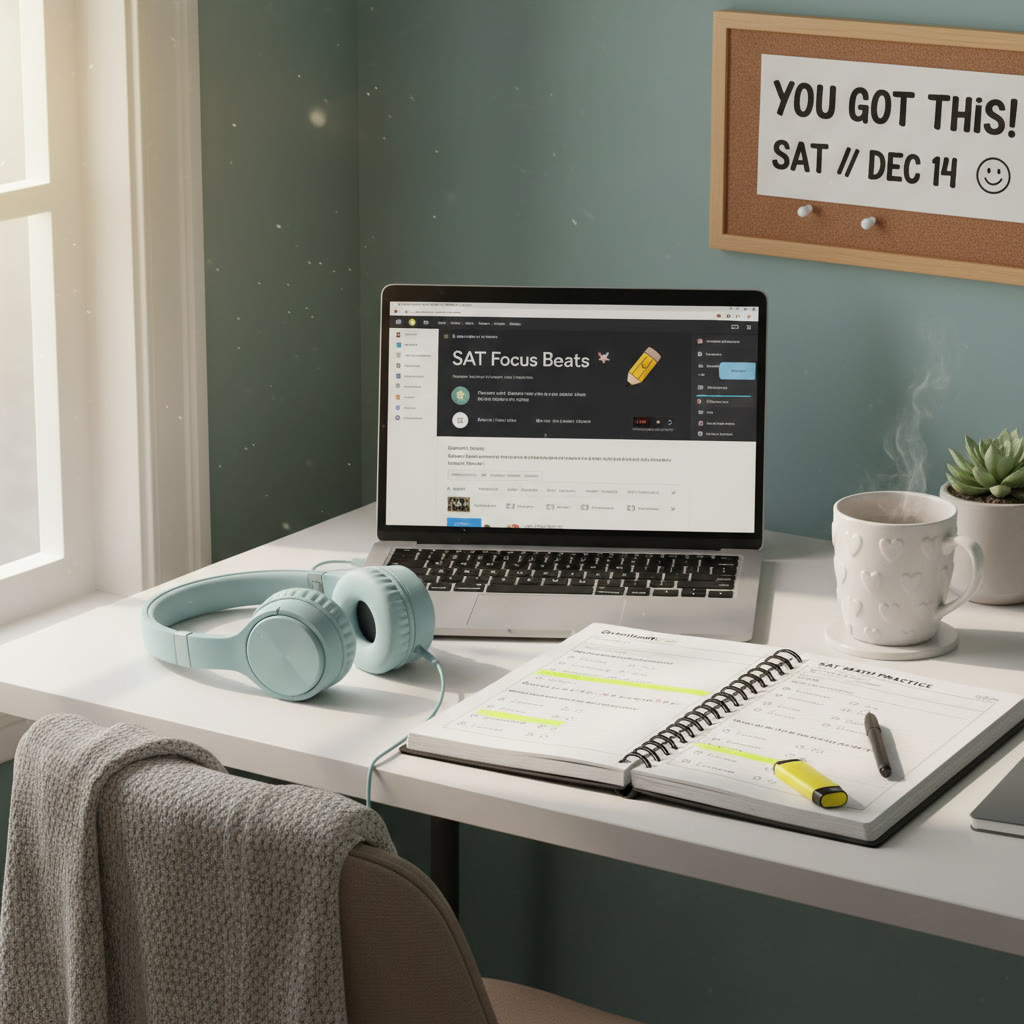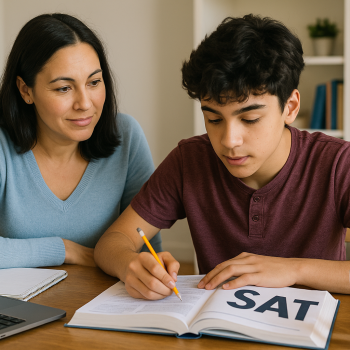How to Use Music for Better Focus During SAT Study Sessions
Music is one of those tiny, powerful tools that can turn a ho-hum study session into something surprisingly productive. If you’ve ever noticed how a certain playlist can lift your mood or make time fly, you’re not imagining things. For SAT prep, where concentration and stamina matter as much as content knowledge, music can be a gentle secret weapon—if you use it thoughtfully.
This guide walks you through the why and how: the science behind music and attention, practical choices for different SAT tasks (Reading, Writing and Language, Math), tempo and volume tips, sample playlists, and a few cautions so music helps rather than hinders. I’ll also touch on how Sparkl’s personalized tutoring and benefits—1-on-1 guidance, tailored study plans, expert tutors, and AI-driven insights—can help you pair the right study routines with the right soundtrack.
Why music can help (and when it can’t)
At its best, music acts as a cognitive backdrop. It can reduce stress, mask distracting noise, and create a predictable environment your brain interprets as “study time.” Two reliable effects show up in research and everyday experience:
- Music can improve mood and motivation. A positive mood often translates into longer, more consistent study blocks.
- Repetition and familiarity in music can lower the mental cost of background stimulation, freeing resources for the task at hand.
But music isn’t a universal panacea. Complex or highly engaging tracks—think loud songs with shifting rhythms, heavy lyrics, or unexpected changes—can steal cognitive resources that you need for problem solving or reading comprehension. That’s why the key isn’t “turn on music” so much as “choose and use music intentionally.”
The science in plain language
Neuroscience suggests that predictable background music helps maintain consistent arousal levels: not too sleepy, not overwhelmed. For tasks that rely on working memory (like algebra or sentence correction), minimizing distraction is crucial. For repetitive or endurance tasks (like completing lots of practice questions), music that lifts mood and reduces perceived effort can boost stamina.
A special note on binaural beats and alpha/theta music: some studies report modest improvements in attention with binaural beats or low-alpha stimulation, but results vary and effects are often small. Consider these as experimental tools rather than guaranteed fixes.
Choosing the right music for different SAT tasks
Different parts of the SAT ask for different mental modes. Here’s a simple way to match music to task:
- Reading: low-lyric or instrumental music, slower tempos, low volume.
- Writing & Language: light instrumentals or ambient music, avoid lyrical distraction during editing tasks.
- Math: depends on the phase—use silent focus for new, complex concepts; steady, rhythmical instrumentals for practice and problem sets.
Practical examples
Imagine you’re attacking a timed practice Reading section. You might start with a 5–10 minute warm-up playlist of calm, lyric-free pieces to settle in. During each passage, keep the volume low or consider silence for the most complex paragraphs. For a long math drill, a continuous instrumental mix at a steady tempo helps you stay in a rhythm without pulling your attention away.
Tempo, volume, and lyrics: the three critical settings
A good rule of thumb: tempo influences arousal, volume influences distraction, and lyrics influence cognitive load.
- Tempo (BPM): Slower tempos (60–80 BPM) encourage calm and deep focus. Medium tempos (80–110 BPM) work well for steady practice and tasks that require a bit of energy. Fast tempos (above 110 BPM) can be energizing but might reduce accuracy on detail-oriented tasks.
- Volume: Keep music at a level where it doesn’t compete with inner speech. If you find yourself mouthing words or rereading sentences because of the music, turn it down. A good test: you should still be able to focus on the task without consciously noticing the tune.
- Lyrics: Avoid lyrics for reading comprehension, close editing, and learning new algebra concepts. Lyrics introduce competing language processing, which is bad news for language-heavy tasks.
Music recommendations by SAT section
Below are practical, section-specific suggestions. Think of these as starting points rather than rigid rules—personal taste, study environment, and attention profile matter.
Reading
Goal: deep focus and comprehension.
Choose low-lyric or instrumental music with slow to moderate tempo. Ambient piano, soft classical, or minimal electronic music work well. The idea is to create a gentle, constant background that reduces jumpiness and allows you to sink into passages.
Writing and Language
Goal: clarity and linguistic precision.
Small doses of instrumental jazz, light classical, or acoustic guitar can keep energy up without adding words that compete with sentence structure. When editing a tricky sentence, consider brief silence during the actual correction to avoid interference.
Math
Goal: sustained concentration and pattern recognition.
For learning new concepts, silence or very quiet background music helps because you need working memory for step-by-step reasoning. For practice sets, a rhythmical instrumental playlist (steady BPM, no sudden changes) helps maintain momentum and reduces the temptation to procrastinate.
Sample playlists and settings
Below is a compact table you can use as a cheat sheet when you build playlists. It groups study activity, recommended kinds of music, suggested BPM ranges, and the reason it works.
| Study Activity | Recommended Music | Approx. BPM | Volume | Why it works |
|---|---|---|---|---|
| Reading passages | Ambient piano, minimal classical | 60–80 | Low (background) | Promotes calm focus and reduces startle distractions |
| Grammar & editing | Light acoustic, soft jazz instrumentals | 70–90 | Low–medium | Maintains clarity without adding linguistic load |
| Math practice | Rhythmic electronic, instrumental post-rock | 80–100 | Medium | Creates momentum for repetitive problem solving |
| Timed full sections (stamina) | Continuous instrumental mixes or lo-fi beats | 75–95 | Low–medium | Supports long focus periods and reduces monotony |
| Warm-up / quick review | Upbeat instrumentals or familiar, non-distracting songs | 90–120 | Medium | Boosts motivation and energy before studying |
How to build study playlists that actually help
Creating a playlist takes a little experimentation. Here’s a step-by-step routine that many students find helpful:
- Start with purpose: pick a playlist for a clear activity—”Reading Focus,” “Math Drill,” or “Grammar Flow.”
- Choose tracks with similar energy: avoid abrupt shifts in intensity or tempo that can yank attention away.
- Prefer instrumental mixes or tracks where the melody is simple and predictable.
- Include a 5–10 minute warm-up track to mark the start of a study block—the brain learns cues.
- Use the last minute or two of a playlist as a natural cue to wrap up or take a break (useful for Pomodoro-style sessions).
One practical example
Say you plan a 50-minute math session: 5 minutes warm-up (soft rhythmic instrumental), 35 minutes focused problem sets with steady BPM, 5–8 minutes cool-down with quieter, slower music to reflect on mistakes, and a brief silent review of the toughest question. Over time your brain will associate that warm-up track with entering focused study mode, which can shorten the time it takes to concentrate.
Study rhythms: using Pomodoro and music together
Music pairs particularly well with structured study rhythms. A common approach is the Pomodoro method: 25 minutes work, 5 minutes break, repeated. Here’s how to align music with Pomodoro:
- Work interval: choose a playlist that matches the task (instrumental, steady tempo).
- Short break: switch to a lighter, upbeat track or silence—use this to stand up, hydrate, and rest your eyes.
- Long break (after 3–4 cycles): it’s okay to listen to songs you enjoy with lyrics, but keep breaks bounded so momentum isn’t lost.
Using different playlists for work and break helps condition your brain: the work playlist becomes a cue for focus, and the break playlist signals downtime.
When music can hurt your score
Don’t rely on music when learning brand-new concepts or tackling a practice test that mimics real test conditions. Here are specific times to switch music off:
- During full-length practice tests—simulate actual test conditions; the real SAT will be quiet.
- When you’re trying to memorize dense rules or vocabulary that require internal verbal rehearsal.
- If you notice frequent re-reads, mistakes because of inattention, or persistent distraction—these are signs music is costing more than it gives.
Personal differences: what if you’re easily distracted or have ADHD?
Individuals vary a lot. Some students with ADHD find that steady, slightly arousing background music helps focus; others need complete silence. If you’re experimenting, try short cycles: 20–30 minutes with music, then 10 minutes silent, and track performance. Sparkl’s personalized tutoring can be particularly helpful here—an expert tutor can observe how you respond and tailor study strategies and playlists to your attention profile, using 1-on-1 guidance and AI-driven insights to refine what works.
Practical tips for listening setup
- Use comfortable headphones: on-ear or over-ear with soft pads are best for long sessions. Avoid uncomfortable buds that pull your attention away.
- Noise-canceling helps in noisy environments, but be cautious with complete isolation if you need to stay aware of time or household cues.
- Keep device controls handy: being able to lower volume quickly or skip a distracting track without floundering helps maintain flow.
Test-day strategy
On test day, you won’t be able to use music in the room, so use music strategically during your final prep, not as a test crutch. The week of the exam, practice at least a few timed sections in silence so your body and mind remember how to perform without auditory support. Use Sparkl’s tailored study plans or an expert tutor to build a practice schedule that balances music-aided sessions with dry runs that replicate test conditions.
Examples and real-world scenarios
Here are two short, realistic scenarios to illustrate music use during SAT prep.
Scenario 1: Emma, the calm reader
Emma struggles with staying engaged through long reading passages. She creates a “Reading Focus” playlist of soft piano pieces at 65 BPM. She uses that playlist during all her reading practice and pairs it with 30-minute study blocks. Over a few weeks she notices she starts to settle faster at the beginning of each session—the playlist has become a signal for focused reading. For full-length practice tests she trains herself to do the same work in silence, gradually reducing dependence on the playlist for endurance rather than comprehension.
Scenario 2: Jordan, the problem-solver
Jordan finds silence too sleepy for long math drills. He builds a rhythmic instrumental playlist—steady beats, no lyrics, around 90 BPM. He uses it for practice sets, but switches to silence when learning brand-new concepts. With his Sparkl tutor, he gets help designing these routines: the tutor suggests alternating between music-driven practice for stamina and quiet study for heavy cognitive load, and Sparkl’s AI-driven insights track his error rates to recommend when to increase or decrease music use.
How Sparkl’s personalized tutoring can enhance your music strategy
Sparkl’s tutoring can make music-based strategies more effective by offering tailored study plans and individualized feedback. An expert tutor will observe which environments and playlists help you focus, then integrate those preferences into a plan—scheduling music-aided drills, silent practice for simulation, and targeted review sessions. Sparkl’s AI-driven insights can analyze patterns in your performance (for example, whether error rates rise when music is on) and suggest tweaks so your soundtrack truly supports your score improvement.
Final checklist: quick rules to follow
- Match music to the task: instrumental for reading; quiet for new concepts; rhythmic for drills.
- Keep volume low and tempo steady.
- Avoid lyrics during language-heavy tasks.
- Use music as a cue: consistent playlists help condition focus.
- Practice in silence for full-length tests so you’re ready for test-day conditions.
- Track results: if you make more mistakes with music, change it or go silent.

Wrapping up: music as a smart study companion
Music can be a subtle, enjoyable edge in your SAT prep toolkit—when it’s chosen with purpose. It can set the tone for focus, increase study stamina, and even make long practice days more pleasant. The trick is to test and measure: notice whether your accuracy and stamina improve, adjust tempo and volume, and mix music-aided sessions with silence so you’re prepared for the real conditions of the SAT.
And if you want help building routines that match your learning style, consider working with a tutor who integrates these habits into your study plan. Sparkl’s personalized tutoring—with 1-on-1 guidance, tailored study plans, expert tutors, and AI-driven insights—can help you design playlists and study rhythms that fit your attention style and the demands of the test.
Takeaway
Start small: pick one playlist per study activity, commit to a week of consistent use, and track how your focus and scores change. With thoughtful choices and a little experimentation, music won’t be a distraction—it will be part of your strategy for calmer, more effective SAT study sessions.















No Comments
Leave a comment Cancel